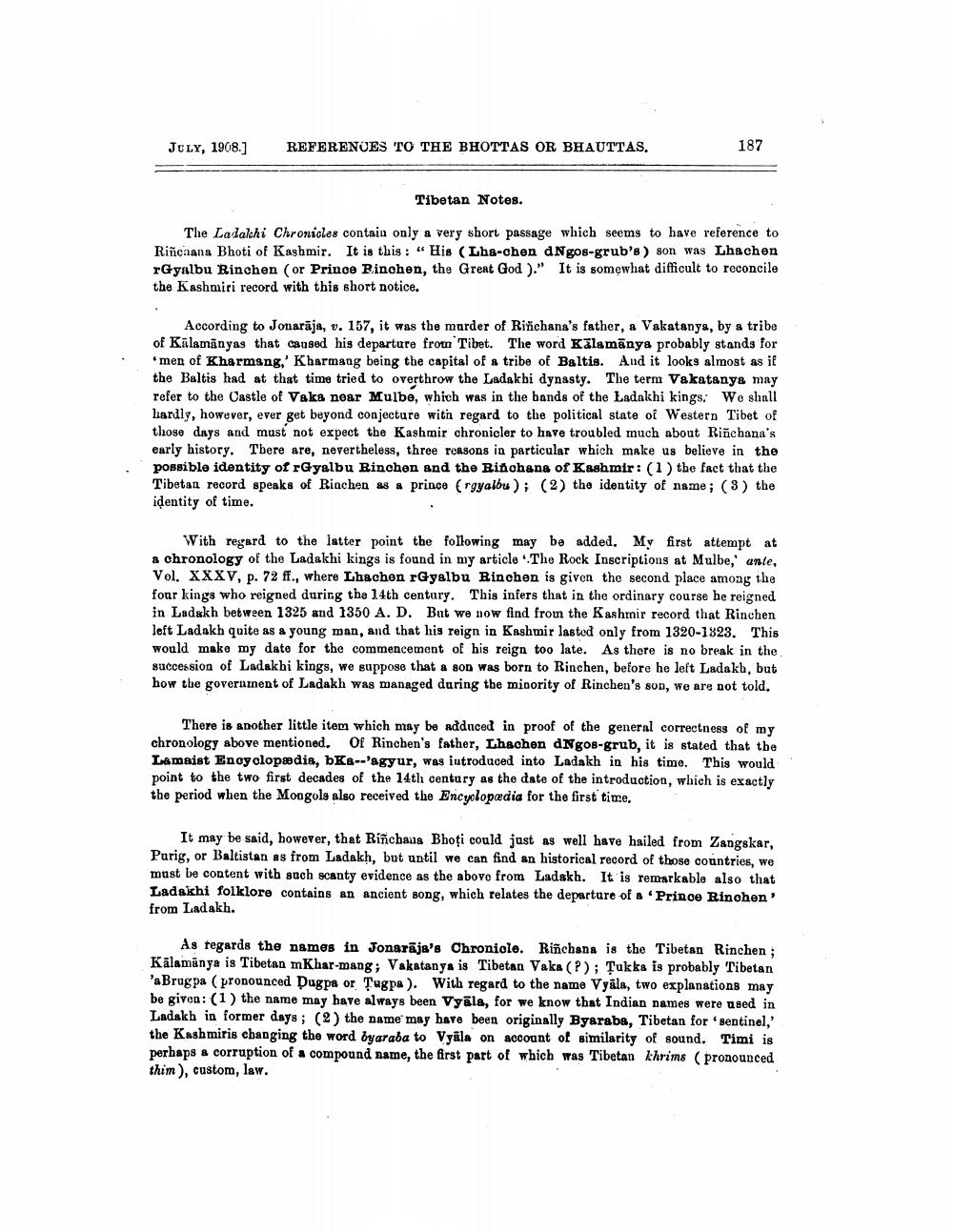________________
JULY, 1908.)
REFERENCES TO THE BHOTTAS OR BHAUTTAS.
187
Tibetan Notes.
The Ladakhi Chronicles contaia only a very short passage which seems to have reference to Riñchana Bhoti of Kashmir. It is this: "His (Lha-chen d Ngos-grub's ) son was Lhachen rGyalbu Rinchen (or Prince Binchen, the Great God )." It is somewhat difficult to reconcile the Kashmiri record with this short notice.
According to Jonarāja, v. 157, it was the murder of Ritchana's father, a Vakatanya, by a tribe of Kālamanyas that caused his departure from Tibet. The word Kālamānya probably stands for men of Kharmang,' Kharmang being the capital of a tribe of Baltis. And it looks almost as if the Baltis had at that time tried to overthrow the Ladakbi dynasty. The term Vakatanya may refer to the Castle of Vaka near Mulbe, which was in the bands of the Ladakhi kings. We shall hardly, however, ever get beyond conjecture with regard to the political state of Western Tibet of those days and must not expect the Kashmir chronicler to have troubled much about Riñchana's early history. There are, nevertheless, three reasons in particular which make us believe in the possible identity of Gyalbu Rinchen and the Binohana of Kashmir: (1) the fact that the Tibetan record speaks of Riachen as a prince (rgyalbu ); (2) the identity of name; (3) the identity of time.
With regard to the latter point the following may be added. My first attempt at a chronology of the Ladakhi kings is found in my article The Rock Inscriptions at Mulbe,' ante, Vol. XXXV, p. 72 ff., where Lhachen Gyalbu Rinchen is given the second place among the four kings who reigned during the 14th century. This infers that in the ordinary course he reigned in Ladakh between 1325 and 1350 A. D. But we now find from the Kashmir record that Rinchen left Ladakh quite as a young man, and that his reign in Kashmir lastod only from 1320-1823. This would make my date for the commencement of his reign too late. As there is no break in the succession of Ladakhi kings, we suppose that a son was born to Rinchen, before he left Ladakh, but how the government of Ladakh was managed during the minority of Rinchen's son, we are not told,
There is another little item which may be adduced in proof of the general correctness of my chronology above mentioned. Of Rinchen's father, Lhachen dNgos-grub, it is stated that the Lamaist Enoyolopædia, Ka--'agyur, was iutroduced into Ladakh in his time. This would point to the two first decades of the 14th century as the date of the introduction, which is exactly the period when the Mongols also received the Encyclopædia for the first time.
It may be said, however, that Riñchaua Bhoți could just as well have hailed from Zangskar, Purig, or Baltistan as from Ladakh, but until we can find an historical record of those countries, we must be content with such scanty evidence as the above from Ladakh. It is remarkable also that Ladakhi folklore contains an ancient song, which relates the departure of a Prince Rinchen from Ladakh.
As tegards the names in Jonarāja's Chronicle. Riñchana is the Tibetan Rinchen; Kālamänya is Tibetan mKhar-mang; Vakatanya is Tibetan Vaka (?); Tukka is probably Tibetan 'a Brugpa (pronounced Dugpa or Tugpa). With regard to the name Vyala, two explanations may be given: (1) the name may have always been Vyāla, for we know that Indian names were used in Ladakh in former days; (2) the name may have been originally Byaraba, Tibetan for sentinel,' the Kashmiris changing the word byaraba to Vyala on account of similarity of sound. Timi is perhaps a corruption of a compound name, the first part of which was Tibetan khrims (pronounced thim), custom, law.




